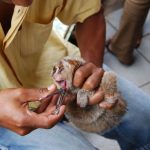Slow loris is dying
 Selfie tourism is the latest thing to kill the slow loris
Selfie tourism is the latest thing to kill the slow loris
BY ISOBEL HAMILTON From Mashable
Warning: this article contains images of animal abuse which some may find distressing.
A small furry creature huddles close to a tree branch on the edge of the forest. Its large, globular eyes are shut (it’s daytime, and so now it sleeps); its strong hands and arms hold firm even as it slumbers.
In a deep sleep, the creature doesn’t hear the rustling of approaching predators. Before it knows what’s happening, it’s plucked from the tree and bundled into a bag. When it is finally taken out into the blinding light of day, metal pliers are forced into its mouth to clip its teeth. Then it is shoved into a wire cage, alone and in pain.
Later it is sold for the price of half a pack of cigarettes. A little bit later still, it’s in a photo on Instagram. It is accompanied by the hashtags #slowloris #adorable #squee.
This is just one example of a growing trend which is afflicting many cute and cuddly wild animals across the world.
“Efforts are needed to continue to raise awareness of the plight of slow lorises,” is the conclusion to an investigation published earlier this year. “Without a change in attitude from the public, the use of slow lorises as photograph props is likely to continue and to spread.”
Indeed, far from abating, the abuse of the slow loris through social media has taken on yet another dimension in the form of so-called “selfie tourism”.
The background
The slow loris is a small primate that lives in the forests of east Asia. We humans have long posed a threat to the loris — over the past 24 years the Javan slow loris population is suspected to have declined at least 80% due to the pet trade.
But for many people around the world their first introduction to the creature was online. The first hugely popular loris video appeared in 2009 and it showed a loris being “tickled”. For many people this was the first time they’d ever heard of a loris, let alone seen one. More videos followed: lorises clutching tiny umbrellas and nibbling shyly on balls of rice. And so the loris exploded into our collective imaginations as an adorable ball of fluff with eyes to give a Disney princess an inferiority complex.
How was anyone to know the lorises in these images were suffering terribly?
The adorable animals that we have been watching so avidly were obese, diseased, and in terrible distress. But we failed to notice this because the internet did what the internet does best: it decontextualised them.
We immediately acclimatized to seeing lorises in a domestic environment. The truth is that they are unbelievably ill-suited to being kept as pets. Here are just a few reasons why:
Venemous bite: lorises are the only primate with a venomous bite, so people who sell them as pets often clip their teeth in order to neutralize this.
Obesity: in the wild lorises eat tree gum, but people who keep them as pets are often unaware of this. They feed them things like rice and fruit, which although very healthy for humans are way more calorific than the loris’ natural diet, which leads to obesity.
Sensitive eyes: lorises’ eyes are adapted for their nocturnal lifestyle, so being around artificial lights is extremely harmful to their eyes and can cause disease and infection.
Toxic urine: lorises’ urine is highly toxic, a fact which doesn’t pose a problem in the wild where they pee happily onto the forest floor. In captivity, however, they tend to end up sitting in pools of their own highly damaging urine which, especially when they’re put in nappies (which is not uncommon), leads to necrosis, a.k.a. gangrene — the death of living tissue.
The domino effect
So there are a whole glut of reasons why a loris should never be kept as a pet, but that hasn’t stopped the internet acting as a catalyst in stimulating an ultimately cruel trend around the world. The domestic pet trade has long plagued loris populations, but the proliferation of cute loris videos led to an unprecedented international demand. UK expert Anna Nekaris told Mashable lorises are now popping up in places as far-flung Saudi Arabia, Russia, and Poland — although Japan remains the number one destination for illegally traded lorises.
Social media both stimulates and facilitates the illegal trade of lorises. Closed Facebook groups are increasingly being used to advertise the sale of animals, and they pose a serious problem for enforcement because they are hard to find and shut down.
In September, Indonesian police were able to seize nine slow lorises destined for sale on Facebook, but in general it’s incredibly difficult for law enforcement to monitor these groups. Animal welfare groups have questioned how seriously Facebook is taking the matter of their platform being used as a facilitator for illegal trade.
“We urge Facebook to support efforts to stop wildlife trafficking by blocking and reporting Facebook users who advertise or post pictures of protected wildlife,” said Karmele Llano Sanchez, Programme Director of International Animal Rescue Indonesia, after the Indonesia find.
Mashable reached out to Facebook to ask how they deal with illegal animal trade on their platform. Facebook told us that it prohibits people using their platform for the illegal trade of animals, but were not specific as to how it tackles the problem of traffickers establishing criminal networks using closed groups.
More than a pet
Another problem that’s come to the fore is the fact that lorises aren’t just being bought as pets anymore. People around the world have cottoned on to the loris’ photogenic appeal and are cashing in. Increasingly, lorises have been sold as photo props, a practice which came to light in 2013 when Rihanna posted a picture on Instagram of herself posing with a loris in Thailand.
Loris selfie tourism has now spread well beyond the loris’ natural range. An investigation by Honor Kitson and Anna Nekaris from summer of this year discovered a number of lorises in Marmaris, Turkey. They were being used in bars as photo props to attract customers. People paid about 10 lira ($2.75 USD) to have their picture taken with the animal.
Sites like Facebook and Instagram have come under heavy fire for facilitating selfie tourism, especially after a recent report from World Animal Protection exposed the impact it has had on animals in the Amazon.
“With over 700 million users and 92 million images uploaded to its site every day, Instagram has the power and influence to protect hundreds of thousands of wild animals,” the report states.
Instagram had this to say in response:
“We prohibit the use of Instagram to facilitate or organize criminal activity that causes physical harm to animals. We remove reported content that promotes poaching of endangered species or the sale of animals for organized fight, and that includes acts of animal abuse. We are in ongoing conversations with wildlife experts and are looking at ways to provide our community with information around activities that can be harmful to animals and nature, such as posting content that may depict exploitation of wildlife and bad welfare practices.”
Mashable reached out to Facebook to ask about their policy regarding reporting images of animal abuse. The campaigner Anna Nekaris told Mashable that she successfully campaigned for a specific ‘report animal abuse’ option to be introduced on Facebook to make the job of animal welfare campaigners that much easier. She told us the option was later removed with no explanation. Facebook has thus far been unable to confirm or deny the existence of this option.
Fighting an image problem
Some effort has already been made to combat the loris’ online image problem. Nekaris started the The Little Fireface Project back in 2011, and International Animal Rescue founded Tickling is Torture in 2015. The campaign aims to educate people about the problems with so-called cute loris vids, asking them to sign the pledge not to share exploitative videos. Their video has had over 122 million views since 2015, and almost 700,000 people have signed the petition.
But what else can be done?
As the inventors and mass consumers of social media, we have the power to harness the internet’s strength for good. So how best can the average social media user help fight the extinction of the loris?
Tickling is Torture recommends if you see an image or a video of a loris being exploited, don’t share it. If you see a friend sharing that sort of content, or perhaps even posing with a loris in a holiday pic, the campaign recommends a course of action similar to this:
Privately message the friend with a link to the campaign video
Be very non-confrontational and gentle
Send something along the lines of:
“I saw your holiday photo and thought it was so cute and so did some more research into the little animal and I found out something so sad! They are actually treated really badly as photo props and are taken from the wild and as a result are now in danger of going extinct. This is the video I watched: www.ticklingistorture.org, it’s really sad but I just thought you might like to know as maybe you should not post the photo but instead tell others about the truth? I also thought it was cute and am so shocked.”
The Little Fireface Project has also been producing wholesome loris memes in an effort to re-contextualise the animal in a healthy way:
The proliferation of abusive videos as entertainment is not unique to slow lorises; they are far from being the only animal threatened by selfie tourism and trafficking. But so many experts and organisations have called on social media platforms to reform their practises now, it’s hard to say sites like Facebook and Instagram bear no responsibility in curbing this particular trend.
E-commerce sites have been able to take proactive steps in fighting wildlife cybercrime, such as eBay putting a blanket ban on the sale of ivory in 2008, and countries can introduce legislation such as Portugal banning online wild animal trading earlier this year. But social media sites remain reactive in their policy enforcement. (Granted they are grappling with the fact that their platform is being used for something it was not designed for, and of course monitoring accounts always runs a risk of policy infringement.)
As a species we are entranced by animals like the loris. We need to enact change as well as demand it from social media platforms, though, otherwise we will have to wave goodbye to species like them.
Because, despite this relative uptake in awareness, the loris vids are not dead. This August a video went viral of a loris “pole-dancing” in Russia. It’s evidently being kept as a pet, exposed to artificial light, and wearing a nappy.
The fight to stop the spread of “cute” loris content is far from over.
MAGES:
The slow loris, an animal so photogenic it may go extinct.IMAGE: VICKY LETA/MASHABLE
LITTLE FIREFACE PROJECT
These lorises have been captured for the illegal wildlife trade. IMAGE: INTERNATIONAL ANIMAL RESCUE
A loris having its teeth clipped. IMAGE: INTERNATIONAL ANIMAL RESCUE
A loris awaiting sale. IMAGE: INTERNATIONAL ANIMAL RESCUE
For more on this story go to: http://mashable.com/2017/11/18/slow-loris-selfie-tourism-facebook-cute-animal/?utm_source=feedburner&utm_medium=feed&utm_campaign=Feed%3A+Mashable+%28Mashable%29#agS6..E2fPq4







